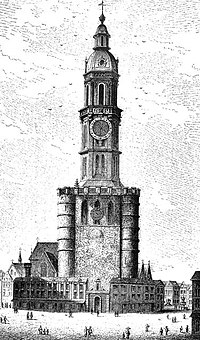
The Grand-Place or Grote Markt is the central square of Brussels, Belgium. It is surrounded by opulent Baroque guildhalls of the former Guilds of Brussels and two larger edifices; the city's Flamboyant Town Hall, and the neo-Gothic King's House or Bread House building, containing the Brussels City Museum. The square measures 68 by 110 metres and is entirely paved.

The Royal Theatre of La Monnaie is an opera house in central Brussels, Belgium. The National Opera of Belgium, a federal institution, takes the name of this theatre in which it is housed—La Monnaie in French or De Munt in Dutch—referring both to the building as well as the opera company. As Belgium's leading opera house, it is one of the few cultural institutions to receive financial support from the Federal Government of Belgium. Other opera houses in Belgium, such as the Vlaamse Opera and the Opéra Royal de Wallonie, are funded by regional governments.

The Cathedral of St. Michael and St. Gudula, usually shortened to the Cathedral of St. Gudula or St. Gudula by locals, is a medieval Catholic cathedral in central Brussels, Belgium. It is dedicated to Saint Michael and Saint Gudula, the patron saints of the City of Brussels, and is considered to be one of the finest examples of Brabantine Gothic architecture.

The Belfries of Belgium and France are a group of 56 historical buildings designated by UNESCO as World Heritage Sites, in recognition of the civic belfries serving as an architectural manifestation of emerging civic independence from feudal and religious influences in the former County of Flanders and neighbouring areas which once were possessions of the House of Burgundy.
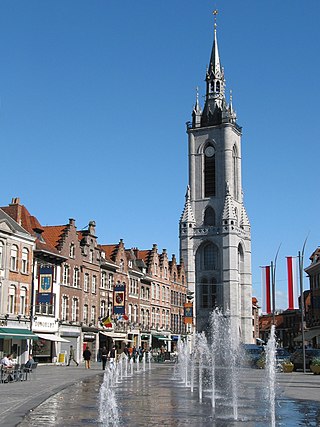
The Belfry of Tournai is a freestanding bell tower of medieval origin in Tournai, Belgium, 72 metres (236 ft) in height with a 256-step stairway. This landmark building is one of a set of Belfries of Belgium and France registered on the UNESCO World Heritage List in recognition of their civic architecture and importance in the rise of municipal power in Europe.
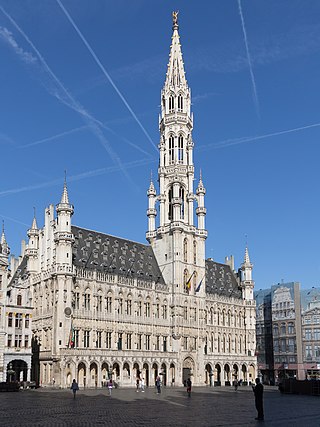
The Town Hall of the City of Brussels is a landmark building and the seat of that municipality of Brussels, Belgium. It is located on the south side of the Grand-Place/Grote Markt, opposite the neo-Gothic King's House or Bread House building, housing the Brussels City Museum.
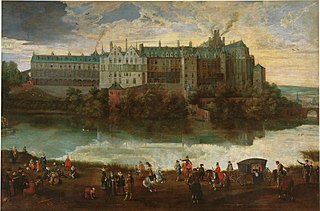
The Palace of Coudenberg was a royal residence situated on the Coudenberg or Koudenberg, a small hill in what is today the Royal Quarter of Brussels, Belgium.

The Bortier Gallery is a glazed shopping arcade in central Brussels, Belgium. It was designed by Jean-Pierre Cluysenaer in 1847, in a neo-Renaissance style, and opened in the following year. As well as being one of the first European shopping arcades, it is a fine example of the joint use of cast iron and glass.
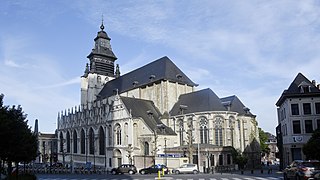
The Church of Our Lady of the Chapel, or the Chapel Church, is a Catholic church in the Marolles/Marollen district of Brussels, Belgium. It is dedicated to Our Lady of the Chapel.

The Halle Gate is a former medieval city gate and the last vestige of the second walls of Brussels, Belgium. Built between 1381 and 1383, it was heavily restored in the 19th century in its current neo-Gothic style by the architect Henri Beyaert. It is now a museum dedicated to the medieval City of Brussels, part of the Royal Museums of Art and History (RMAH).
Peter van Dievoet was a Flemish Baroque sculptor, statuary, wood carver and designer of ornamental architectural elements active in Brussels and England. He is known for his work on a number of the Baroque guild houses on the Grand-Place, which was rebuilt after the bombardment of 1695, as well as on the Statue of James II on Trafalgar Square, London, made in collaboration with fellow Flemish sculptor Laurens van der Meulen. He was the half-brother of Philippe van Dievoet, goldsmith to King Louis XIV of France and the uncle of the Parisian printer Guillaume Vandive.

The Place Royale or Koningsplein is a historic neoclassical square in the Royal Quarter of Brussels, Belgium. Modelled after the so-called French royal square and built between 1775 and 1782, according to a plan of the architects Jean-Benoît-Vincent Barré and Gilles-Barnabé Guimard, to replace the former Palace of Coudenberg, it was part of an urban project including Brussels Park.

The Church of St. James on Coudenberg is a Catholic church on the historic Place Royale/Koningsplein, in the Royal Quarter of Brussels, Belgium. It is dedicated to Saint James, one of the Twelve Apostles of Jesus.
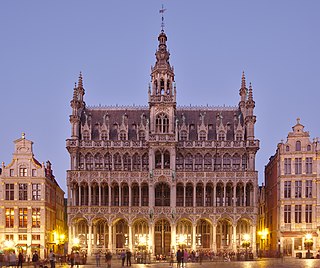
The Brussels City Museum is a municipal museum on the Grand-Place/Grote Markt of Brussels, Belgium. Conceived in 1860 and inaugurated in 1887, it is dedicated to the history and folklore of the City of Brussels from its foundation into modern times, which it presents through paintings, sculptures, tapestries, engravings, photos and models, including a notable scale-representation of the town during the Middle Ages.

Scheut is a district of Anderlecht, a municipality of Brussels, Belgium. Located in the north of Anderlecht, it is bounded by the border with the municipality of Molenbeek-Saint-Jean to the north, the historical centre of Anderlecht to the south, the Birmingham district to the east, the Scheutveld district to the west and the semi-natural site of the Scheutbos to the north-west.
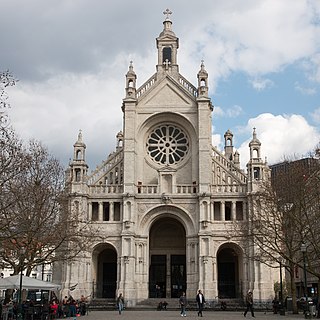
The Church of St. Catherine is a Catholic parish church in Brussels, Belgium. It is dedicated to Saint Catherine.

Gilles van den Eynde was a stonemason, architect, and an important member of the Corporation des Quatre Couronnés in Brussels. Van den Eynde was also a councilor of the City of Brussels until his death. By 8 November 1723 he was replaced by sculptor Peter Van Dievoet.

The Hôtel de Ville is a historic building in Douai, Nord, northern France, standing on the Rue de la Marie. It was designated a monument historique by the French government in 1862.

The Church of St. Nicholas is a Catholic church in central Brussels, Belgium. Founded around 1125, it is one of the first four churches in Brussels and the best preserved in its successive developments. It is dedicated to Saint Nicholas.
